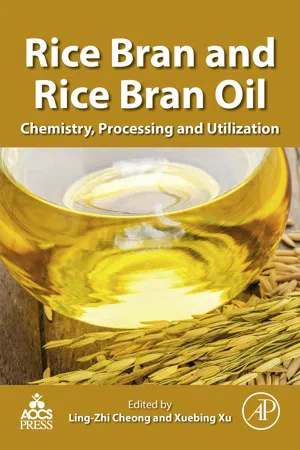
Rice Bran and Rice Bran Oil
Chemistry, Processing and Utilization
- 315 pages
- English
- ePUB (mobile friendly)
- Available on iOS & Android
About This Book
Rice Bran and Rice Bran Oil (RBO) provides much-needed best practices on the science and technology of RBO, including the chemistry, dectection methods, nutrition (including the effect of processing technologies on micronutrients) and applications. RBO contains many nutritional components, including up to 2% oryzanol, tocotrienol, and phytosterols. In addition, the fatty acid composition is well balanced with mainly oleic acid and very little linolenic acid, which allows for versatile uses in frying, cooking, and in formulating oil blends for food uses, especially as a trans-free alternative. Many food industrial sectors are seeking possibilities to use RBO in their products from not only Asia and South America, but also Europe and North America. However, there are many processing, analytical, and nutritional considerations that must be documented in one resource. This volume is perfect for those interested in understanding the many emerging potential uses for this alternative oil.
Written by a team of experts from academia and industry, this book is the first of its kind. In addition, it provides an overview of related rice bran products and their development, including:
• Rice bran protein • Rice dietary fiber • Dietary rice bran/meal • Rice husk/ash applications • Paddy straw applications • Valued added products, including rice bran wax
- Delivers practical application guidance in the selection and storage of raw materials, ensuring processing conditions address stability concerns during production
- Presents simple and reliable detection methods, as well as the international and national rice bran oil standards
- Provides core scientific insights into this trans-free oil option
Frequently asked questions
Information
Chemistry of Rice Bran Oil
Abstract
Keywords
1 Introduction
2 Oil Content of Rice Bran
3 Fatty Acid Composition of Rice Bran Oil
Table of contents
- Cover image
- Title page
- Table of Contents
- Copyright
- Contributors
- Preface
- Chapter 1: Chemistry of Rice Bran Oil
- Chapter 2: Nutritional Studies of Rice Bran Oil
- Chapter 3: Processing Technology of Rice Bran Oil
- Chapter 4: Bioprocessing Technology of Rice Bran Oil
- Chapter 5: Micronutrients in Rice Bran Oil
- Chapter 6: Applications of Rice Bran Oil
- Chapter 7: Analytical Aspects of Rice Bran Oil
- Chapter 8: Development of Rice Bran Functional Food and Evaluation of Its Healthful Properties
- Chapter 9: Rice Husk, Rice Husk Ash and Their Applications
- Chapter 10: Nutritional Ingredients and Active Compositions of Defatted Rice Bran
- Chapter 11: Rice Bran Protein: Extraction, Nutraceutical Properties, and Potential Applications
- Index